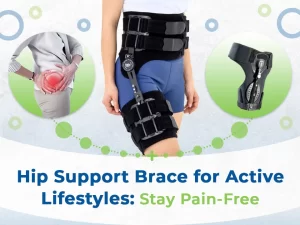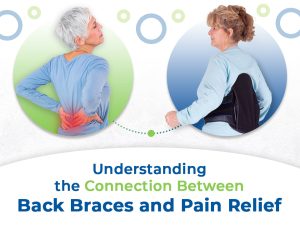As we age, our bodies go through various changes, and unfortunately, one common issue that many seniors face is back pain. Whether it’s due to arthritis, muscle strains, or other conditions, back pain can greatly impact one’s quality of life. Fortunately, options are available to help alleviate this discomfort, such as back braces.
Back braces provide support and stability to the spine and can help reduce pain and discomfort for seniors. In addition to offering physical support, they can also help improve posture and prevent further injury. In this article, we’ll explore the benefits of using back braces for seniors and how they can help relieve pain.
The Benefits of Back Braces for Seniors

Proper Posture and Support
Back braces provide seniors with the proper posture and support needed to reduce strain on the spine. When the back is properly aligned, it takes the pressure off of the vertebrae, muscles, and ligaments that support it, which can help reduce pain and discomfort. Back braces can also help seniors stand up straight, which can improve their appearance, boost their confidence, and help them engage in activities they may have previously avoided due to back pain.
Reducing Pressure on the Spine
Back braces work by providing compression to the lower back and abdominal muscles, which helps to reduce the pressure on the spine. This is especially important for seniors with osteoporosis, where the spine can become fragile and prone to fractures. A back brace can help stabilize the spine and reduce the risk of fractures.
Decreasing Muscle Tension and Strain
Back braces can also help to decrease muscle tension and strain. As we age, our muscles become weaker and less flexible, which can put additional strain on the back. A back brace can help to support the muscles and prevent them from overworking, which can reduce pain and tension in the back muscles.
Improved Mobility and Quality of Life
Back braces can also help seniors improve their mobility and quality of life. By reducing pain and discomfort, seniors can engage in physical activities they may have previously avoided. This can help improve cardiovascular health, strengthen muscles, and improve the overall quality of life.
Types of Back Braces

Rigid Braces
Rigid braces are often used for seniors with severe back pain or injury, as they provide the most support. These braces are typically made of hard plastic or metal and are worn around the torso to limit the movement of the spine. They can be custom-fitted to the individual’s body for maximum effectiveness. Rigid braces are most commonly used after spinal surgery or for conditions like scoliosis, where immobilization of the spine is necessary for proper healing.
Soft Braces
Soft braces are made of flexible materials like neoprene and provide moderate support. They are a good option for seniors who need support but also want to maintain some flexibility and mobility. Soft braces can be worn all day and are typically more comfortable than rigid braces. They are often used for conditions like muscle strain, arthritis, or herniated discs.
Corset Braces
Corset braces are made of rigid and soft materials and provide both support and compression. They are a good option for seniors who need moderate support but also want to maintain some flexibility. Corset braces are typically worn around the waist and can be adjusted to provide more or less compression. They are often used for spinal stenosis, osteoarthritis, or chronic low back pain.
Custom Braces
Custom braces are made to fit the individual’s specific needs and can provide the most support. These braces are typically prescribed by a healthcare professional and are made based on the individual’s unique anatomy and condition. Custom braces can be rigid or soft and are often used for conditions like severe scoliosis, spinal fractures, or spinal cord injuries.
Posture Corrector Braces
Posture corrector braces are designed to promote proper alignment of the spine, which can help reduce back pain and improve posture. These braces are typically made of soft, flexible materials and are worn around the upper back and shoulders. They work by pulling the shoulders back and aligning the spine into a more natural position. Posture corrector braces are a good option for seniors who spend a lot of time sitting or standing, as they can help prevent slouching and improve overall posture.
Read More: The Best Back Brace for Seniors
Choosing the Right Back Brace for Seniors
Consult with a Healthcare Professional
When it comes to back pain, seniors should not self-diagnose or self-treat. Consulting with a healthcare professional, such as a doctor, physical therapist, or chiropractor, can help ensure that the correct diagnosis is made and that the appropriate treatment is prescribed. They can also help seniors determine the type of back brace best suited for their specific needs based on the location and severity of their pain.
Consider the Type of Back Pain
As mentioned earlier, different types of back pain require different support. For instance, seniors with spinal stenosis, which is a narrowing of the spinal canal, may benefit from a rigid back brace that restricts motion in the affected area. On the other hand, seniors with muscle strain may find relief with a soft brace that provides moderate support without limiting mobility.
Ensure Proper Fit
A back brace must fit properly to be effective. Ill-fitting braces can cause discomfort, restrict movement, or even exacerbate the pain. It’s important to take accurate measurements of the waist and torso and choose the appropriate brace size. Seniors should also ensure that the brace is adjustable to be tightened or loosened as needed.
Consider Lifestyle and Comfort
Seniors have different lifestyles and mobility levels, so it’s important to choose a back brace that fits with their daily routine. For example, seniors who lead an active lifestyle may prefer a soft brace that allows them to move freely, while those who spend most of their time sitting may benefit from a rigid brace that provides more support. Additionally, seniors should choose a brace that is comfortable to wear and does not cause irritation or other discomforts. It’s also important to choose a brace that is easy to put on and take off, especially for seniors who have limited mobility or dexterity.
In Conclusion
Back pain is a common issue for seniors, back braces can provide the support and stability needed to reduce pain and improve quality of life. There are several types of back braces to choose from, and seniors should consult with a healthcare professional to determine which is best suited for their specific needs. With the right back brace, seniors can enjoy improved mobility, decreased pain, and a better quality of life.
At Artik Medical Supply, we offer a variety of back braces for seniors. Our expert team can help seniors find the perfect brace that meets their needs and provides the proper support for their back pain.
When choosing a back brace, it’s important to consider the type of back pain, proper fit, lifestyle, and comfort. Our team can help guide seniors through selecting the right back brace, ensuring they receive the maximum benefit and relief from their pain. Connect with us today to check eligibility and see how we can help







